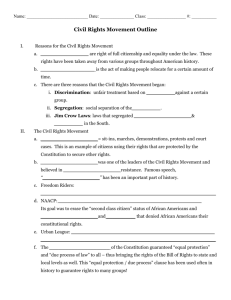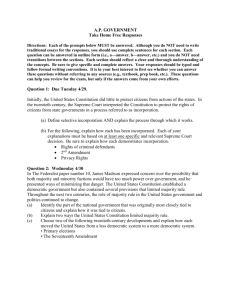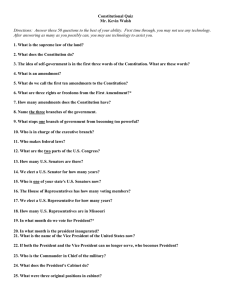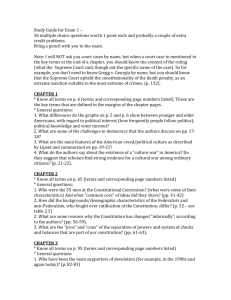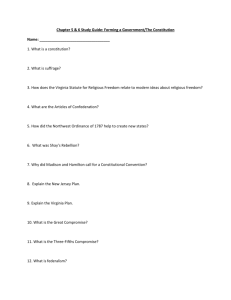Legal Foundations of Education
advertisement
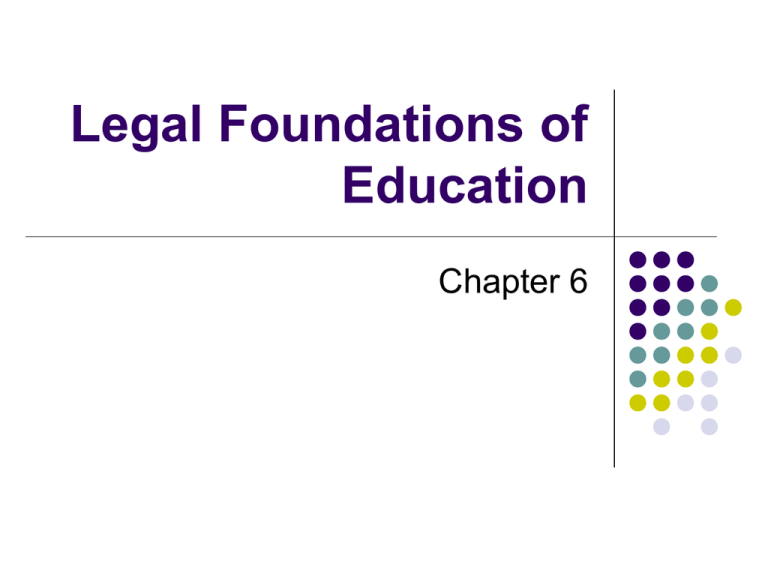
Legal Foundations of Education Chapter 6 Learning Outcomes The U.S. Constitution sets the roles and responsibilities of the states in ensuring public schooling for all children Critical issues between the courts and public schools Court-established guidelines for public funds in private schools Religious activities in public schools Civil rights and affirmative action Rights and responsibilities of teachers Students’ rights and responsibilities The Classroom Teacher Enabling Laws…laws that make it possible for educators to do certain things Judicial Interpretive Process…the judicial process of drawing conclusions about the intent of the wording in the Constitution and statutes The Classroom Teacher Enabling and Legislative Agents…peoples’ rights under the U.S. Constitution, the Constitution of the state, statutes of the state legislature, state school board policies, local school board policies Interpretive and Administrative Agents…local administrative officers, state superintendent of public instruction, opinions of the attorney general, decisions of the state court, decisions of the Supreme Court The U.S. Constitution The fundamental law of the nation…a state legislature has no right to change it The Tenth Amendment…The powers not delegated to the United States by the Constitution, nor prohibited by it to the States, are reserved to the States respectively, or to the people. The U.S. Constitution First Amendment…ensures freedom of speech, religion, the press, as well as the right to petition “Congress shall make no law respecting an establishment of religion, or prohibiting the free exercise thereof; or abridging the freedom of speech, or of the press; or the right of the people peaceably to assemble, and to petition the Government for redress of grievances.” The U.S. Constitution Fourteenth Amendment… “No state shall make or enforce any law which shall abridge the privileges or immunities of citizens of the United States; nor shall any State deprive any person of life, liberty, or property without due process of law; nor deny to any person within its jurisdiction the equal protection of the laws.” U.S. Supreme Court Cases Related to Public Funds Emerson v. Board of Education (1947)…taxraised funds for transportation of students to church schools, ruled that reimbursement did not violated the First Amendment Lemon v. Kurtzman (1971)…direct aid for secular services to nonpublic schools (salaries, texts, materials)…ruled unconstitutional because of excessive entanglement between govt. and religion U.S. Supreme Court Cases Wolman v. Walter (1977) provision of books and materials and therapeutic and remedial services to nonpublic school pupils…ruled constitutional Grand Rapids School District v. Ball (1985), and Aguilar v. Felton (1985) instruction of nonpublic school students in supplementary education by public school teachers…ruled that it violated the establishment clause in that it promoted religion U.S. Supreme Court Cases Zobrest v. Catalina Foothills School District (1993) interpreter for a deaf student attending a Catholic high school…ruled constitutional Board of Education of Kiryas Joel Village School District v. Grumet (1994)…creation and support of a public school district for Hasidic Jews…violated the establishment clause Agostini v. Felton (1997) Title I teachers to serve disadvantaged students in religious schools…assign teachers without regard to religious affiliation, remove religious symbols from classrooms, limited contact with religious personnel, monthly unannounced visits by public school supervisors Child Benefit Theory A criterion used by the U.S. Supreme Court to determine whether services provided to nonpublic school students benefit children and not a particular school or religion Public tax funds to pay for salaries of teachers in religious schools have not been upheld (In Minnesota, a tax deduction has been upheld for parents of children in public and private schools) Practice of Religion in Public Schools Edwards v. Aguillard (1987) balanced treatment of biblical and scientific explanations of the development of life…a state cannot require that schools teach the biblical version of creation Wallace v. Jaffree(1985)prayer in public schools led by teachers, and a period of silence for meditation or voluntary prayer…unconstitutional Religion in the Public Schools Mozert v. Hawkins County Public Schools (1987) request that fundamentalist children not be exposed to basal reading series…rejected Board of Education of the Westside Community Schools v. Mergens (1990) right of a student religious club to hold meetings at a public school…if only one non-curriculum related student group meets, then school may not deny other clubs Lee v. Weisman (1992) religious exercise in a graduation ceremony…unconstitutional Segregation and Desegregation Segregation…legal and/or social separation of people on the basis of their race De jure segregation…the segregation of students on the basis of law, school policy, or a practice designed to accomplish such separation De facto segregation…the segregation of students resulting from circumstances such as housing patterns rather than law or school policy Selected U.S. Supreme Court Cases Plessy v. Ferguson (1896) whether a railway company should be required to provide equal accommodations…court ruled that the 14th amendment required political, not social, equality. Thus the doctrine of “separate but equal” was established Brown v. Board of Education of Topeka (1954)…separate-but-equal doctrine has no place in education, and dual school systems are inherently unequal Affirmative Action Policies and procedures designed to compensate for past discrimination against women and members of minority groups; for example, assertive recruiting and admissions practices Reverse discrimination…a situation in which a majority or an individual of a majority is denied certain rights because of preferential treatment provided to a minority or an individual of a minority Opportunities for Students with Disabilities Section 504 of the Rehabilitation Act (1973), three important themes: equal treatment, appropriate education, handicapped persons Public Law 94-142 (1975) “a free appropriate education” to all children with disabilities between the ages of three and twenty-one IDEA (1992) tighter specifications for the delivery of educational services to children with disabilities Teachers’ Rights and Responsibilities Tenure…a system of school employment in which educators retain their positions indefinitely unless they are dismissed for legally specified reasons through clearly established procedures Rights of nontenured teachers…usually do not have due process rights Academic freedom…the opportunity for a teacher to teach without coercion, censorship, or other restrictive interference Teachers’ Rights and Responsibilities Family Rights and Privacy Act a.k.a., the Buckley Amendment: schools and teachers must maintain confidentiality of student records, and parents must be able to review and challenge the records of their children Educational malpractice…culpable neglect by a teacher in the performance of his or her duties Students’ Rights Right to an education Right to sue Right to due process Right to free speech (Tinker v. Des Moines) 1969, black armbands in protest to military activities in Viet Nam Dress codes and grooming (incite or cause disruptive behavior or pose a health or safety problem) Corporal punishment (Ingraham v. Wright) 1977, may authorize it Student and locker searches…in loco parentis
